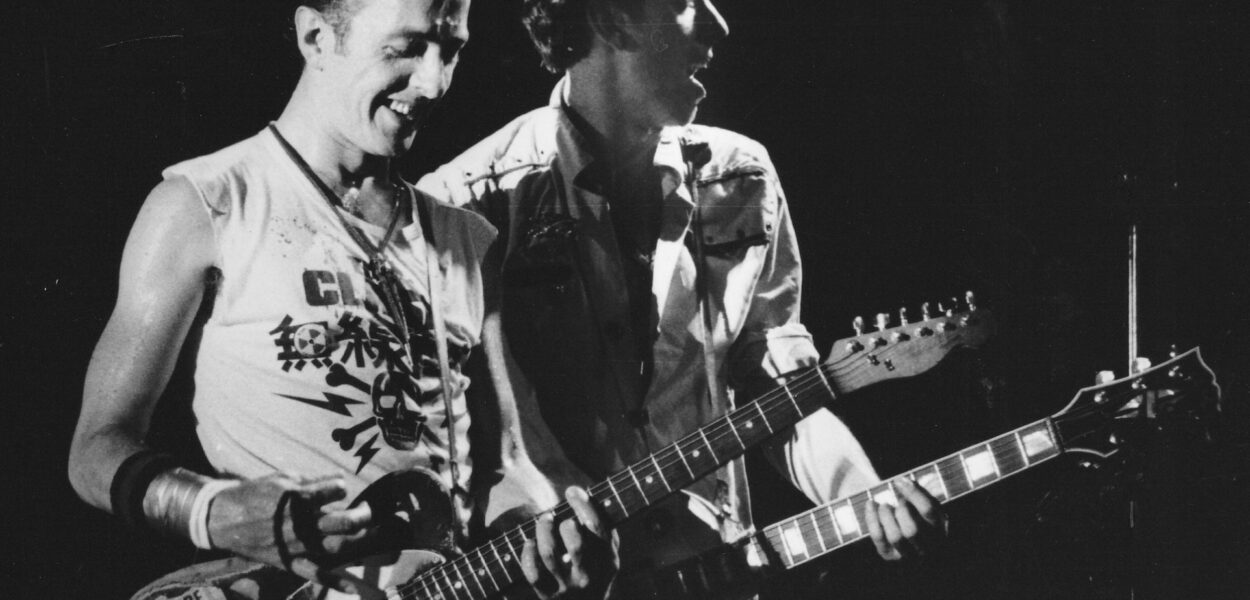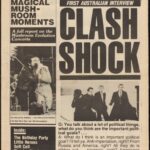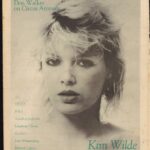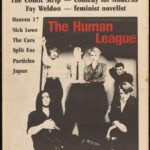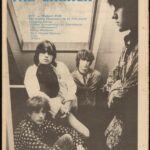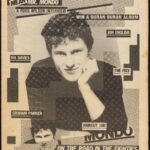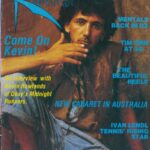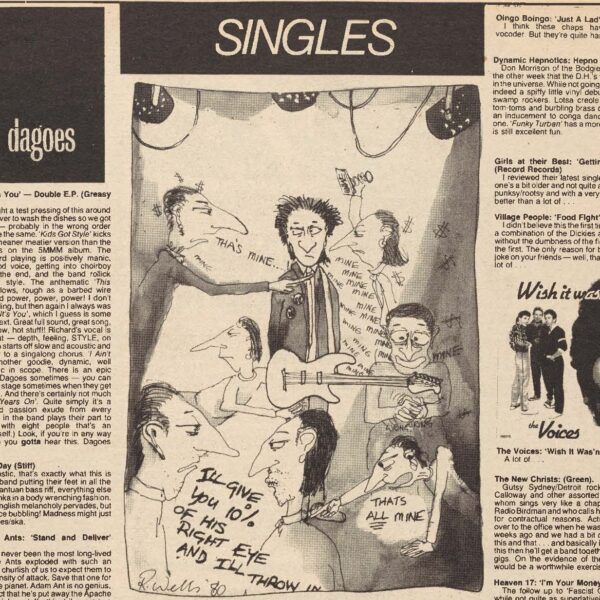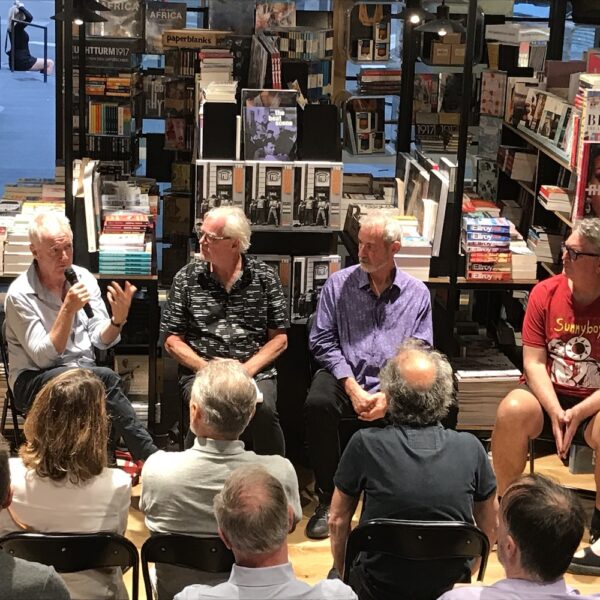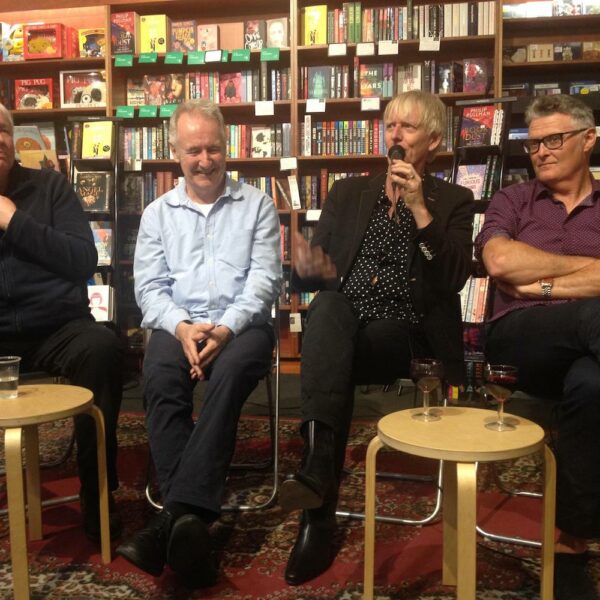To view and download issues, click on thumbnails below
- February 1982
- March 1982
- April 1982
- May 1982
- July 1982
- January 1983
The concerted push to increase sales and advertising revenue following the establishment of a Roadrunner Sydney office in mid-1981 was only a qualified success.
While ad sales saw a marked increase and newsagency sales nudged six thousand for the first time (with the end-of-year issue), most of the extra revenue was offset by the higher production costs of going full colour and printing extra pages, plus extra typesetting and layout costs. Factoring in the costs of running a Sydney office and supporting two Sydney staff meant the magazine entered 1982 still very much a leaky boat.
Jodi Hoffmann joined the Adelaide office. An enterprising young Aboriginal woman from Tea Tree Gully, she organised a placement with the magazine through the Commonwealth Employment Service, which paid her a weekly allowance. She was a budding photographer and I was grateful for her cheery nature, and staunch belief and support in the difficult months to come.
Content-wise, the first issue for 1982 was a corker. With a tabloid-style black-and-white cover screaming ‘Clash Shock!’ the 32 pages contained a transcript of The Clash’s Sydney press conference, a full report on the Mushroom Records Evolution concert, a massive paean to The Birthday Party by Craig N Pearce, a double page retrospective on Creedence Clearwater Revival by Adrian Ryan, glimpses of the coming British New Romantics (Soft Cell, Ultravox and Altered Images) plus a clutch of live and album reviews.
The Clash were magnificent on their one and only Australian tour, but in many ways their visit seemed to signal the end of something. Change was in the air. And putting Kim Wilde on the cover in March signalled an embrace of that change. Chris Salewicz in London wrote the cover story, ‘Portrait of a Pop Princess’. Although the rest of the issue contained the typical new wave faves—Devo, The Police, The Teardrop Explodes, Laughing Clowns, a double-page live review of The Clash and a long interview with Cold Chisel’s Don Walker—it was becoming clear that from the Roadrunner viewing platform the new wave was fast approaching the shore and starting to break.
The April issue reinforced this impression. Synth-rockers The Human League were on the cover, Craig N Pearce got to grips with David Sylvain of fashion plates Japan and there were features on two of the hits of the 1982 Adelaide Festival—feminist author Fay Weldon and ‘new wave’ comedy troupe The Comic Strip. The latter, from London, comprised Alexei Sayle, 20th Century Coyote (Rik Mayall and Ade Edmondson), The Outer Limits (Nigel Planer and Peter Richardson) and (Dawn) French and (Jennifer) Saunders. Fast, fresh and furious—and very funny—who could have predicted members of the group would go on to create such classics as The Young Ones, Absolutely Fabulous and The Vicar of Dibley?
Tiring of chasing their unpaid management fee, G & S Management gave us notice to quit the office at 2 College Road, Kent Town and I found alternative office space five minutes down the road at 92 Rundle Street. There, Jodi Hoffmann managed the phones on days when I was feeling the weight of the world on my shoulders, and struggled to get out of bed and make it into the office.
The focus on non-musical content continued in the May issue. Adrian Ryan sat down with film director Gillian Armstrong in Melbourne to discuss her musical Starstruck, while Jenny Eather described an on-air encounter on Adelaide community radio station 5MMM with Lindsay Kemp, the outrageous English dancer, mime artist, choreographer and teacher. The Church was the cover story and I cut up an interview Giles Barrow did with singer Steve Kilbey in Sydney and interspersed quotes from Richard Neville’s Playpower, Robert Graves’s The White Goddess, Jeff Nuttall’s Bomb Culture and other ‘alternative’ sources. Well, it seemed a good idea at the time.
The financial situation was deteriorating rapidly, however, and in Sydney Lyn Saunders started a little side project called Roadrunner’s Other Magazine, a free gig listing with ads from venues and musical hire outfits. The only problem was he didn’t tell me. When I saw the first issue, I hit the roof.
It was a cheap, shoddy product that reflected badly on the Roadrunner name. The magazine’s reputation had already taken a hit with the ‘paid covers’ scandal of the previous year. This was adding fuel to the fire. I also discovered Saunders had opened a bank account in Roadrunner‘s name and was depositing ad money from the new magazine into it. It was all too much. I told Lyn to stop producing the magazine under Roadrunner‘s name, close the bank account and seek alternative employment. Which, to give him his due, he did.
Scrabbling for ads, copy and enough money to pay the printer, we missed all the deadlines for June 1982, so Vol 5 No 5 came out in July. Geoffrey Gifford offered to design it, on the condition that I give him full control. Normally I would mark up the copy, selecting typefaces and sizes for headlines and body copy, and Richard Turner, Kate Monger and myself would compose each page; then Turner would produce a bromide of any photos to fit the available space. I was more than happy to give Gifford his head and he produced probably the most coherent issue ever in terms of design. The main story was again one without a music focus—a lengthy, illustrated On-The-Road-in-America-in-the-eighties piece by Larry Buttrose.
And, so I thought, that was it. For a couple of years, I had been doing two shows at community radio station 5MMM and when my friend Terry Bradford resigned as programme director in July, I applied for the job. And was successful. A month later, on 27 August (before I’d actually started), I wrote to 5MMM tendering my resignation. I said:
When I accepted the position as programme director, the position of ROADRUNNER seemed hopeless, and I had resigned myself to the fact that the business would have to be wound up and myself going bankrupt in the process. There is now the possibility that that will not happen. It is a possibility that I feel bound to pursue.
What happened? Word had reached Michelle Higgins, national promotions manager at Mushroom Records, that the magazine was in financial trouble. Higgins had been a long-term supporter of the magazine (since her time as promotions manager at Festival Records in Adelaide) and mentioned Roadrunner‘s problems to Lobby Loyde.
Loyde, a legendary Australian guitarist, songwriter and producer, had set up a management company in Sydney called SCAM (Suss City Artist Management) whose roster included Sunnyboys, Machinations and Sardine v. I didn’t know Loyde, but I had met and was impressed by his offsider, Sally Collins, who had brought Sunnyboys to Adelaide on their first SA tour the year before.
Out of the blue, I got a call from Higgins. ‘Give Lobby Loyde a call,’ she said. ‘He wants to make you an offer.’
The conversation went something like this:
‘Lobby? This is Donald Robertson from Roadrunner.’
‘Mate, Michelle Higgins tells me you’re in a bit of financial bother.’
‘Yes, you could say that.’
‘Well mate, I don’t want to see Roadrunner go under. It’s a great little paper.’
‘Err, thanks Lobby.’
‘Why don’t you move to Sydney? There’s space for you here at SCAM. And I’ve got a financial backer who’s willing to invest in the magazine.’
I was on the bus two weeks later.
* * *
Scott Matheson kindly offered me a couch in the terrace he shared with his partner Annette and Riptides manager Paul Nearhos in Reservoir Street, Surry Hills. It was a short walk down Riley Street to 56 Yurong Street, East Sydney—SCAM HQ.
Loyde welcomed me with open arms, showed me the large vacant basement where Roadrunner could set up operations and introduced me to his backer, Michael Heffernan, co-owner of Her Majesty’s Theatre in the Haymarket and principal of Michael Heffernan Investments. Loyde had apprised Heffernan of the magazine’s situation and he agreed to cover my expenses while I set about establishing Roadrunner in Sydney and putting the next issue together.
I got in contact with Michael Zerman, who had been so helpful in evolving Roadrunner to a national set-up four years previously when he was at Adelaide’s Media Resource Centre. Zerman, now based in Bondi, was happy to offer his insights into the Sydney print production environment—printers, typesetters and bromide makers.
There were still bills outstanding in Adelaide—by far the largest to the printer, Bridge Press. I wrote to them and the other creditors, advising them of the situation and assuring them of my best endeavours to pay off the debts from future magazine revenues.
I contacted contributors seeking ideas for stories—Adrian Ryan in Melbourne, Giles Barrow back in Adelaide (where shortly he and his guitar would join legendary Adelaide punksters Exploding White Mice), Brian Johnstone in Darwin, Keri Phillips in New York as well as Sydney contributors Andrew McMillan, John Elder, Arch Brown, Linda Campbell, Patricia Sheahan, Edwina Shannon and Peter Jolly. I made contact with record companies, started collecting records for review and did a few interviews myself—Tom Verlaine of Television, Kevin Rowlands from Dexy’s Midnight Runners, Joe Camilleri from Jo Jo Zep, and Jim Kerr from Simple Minds among others.
Andrew Savage, formerly of RAM, came on board as advertising manager and Simon Penny joined as art director. Penny was a member of Quietly Confident, an alternative cabaret outfit I had been managing in Adelaide since early in the year. Larry Buttrose was also in the group. They had decided to give Sydney a go and all moved up shortly after me. So as well as setting up the magazine, I was seeking gigs for them at venues like Kinselas and Stranded. Speedboat, an Adelaide band I rated highly, also sought a helping hand in the Harbour City and I persuaded Sally Collins at SCAM to find them some engagements, and sang their praises to Virginia Moncrieff at JJJ, Greg Taylor at RAM and other taste makers around town.
Jodi Hoffmann moved up from Adelaide to resume running the Roadrunner office (and taking photos) and by the start of November things were falling into place for the next phase of the magazine.
Cognisant of the trend in music (New Romantics) and music magazines (The Face and Smash Hits) in the UK, I had decided the way forward was a full-colour glossy format and a broadening of the content. Still predominantly a music magazine, the idea was to branch out into travel, sport, film and TV, and other cultural pursuits.
On the production front, I did the rounds and settled on Authotype as the typesetter, Lithomaster for bromides, Offset Alpine as the printer and Network Distribution (part of Kerry Packer’s Consolidated Press group) as the distributor. The print run for the first issue in the new format was 25,000 and cover price was $1.80.
I penned a press release for newsagents.
‘We’ve been away, but now we’re back!! ROADRUNNER, for many years Australia’s most respected music orientated publication will return to the newsagents on 14th December after a hibernation of four months. During that period, the centre of operations has moved from Adelaide to Sydney, and a whole new production and distribution structure has been arranged.
‘The new ROADRUNNER will be half tabloid in size, printed on glossy paper, ensuring better print and photo reproduction and will have a full-colour cover as well as colour inside.
‘The magazine’s editorial base has broadened and as well as contemporary music there will be features in the areas of travel, sport, current affairs, film, video, musical instruments and, in fact, anything that falls within the ambit of popular culture.’
Andrew Savage got a good hearing at the record companies and final ad bookings totalled $5350. Contra deals were organised with commercial FM stations 2MMM Sydney, 3EON Melbourne and SA-FM Adelaide for full-colour ads in exchange for radio spots.
With Kevin Rowlands in full gypsy-clad glory on the cover (Dexy’s ‘Come On Eileen’ had been sitting at number one nationally all through November and December), the issue also had articles on musical acts Tim Finn, The Reels, Simple Minds and emerging African music superstar King Sunny Ade. Features on Senegambia, tennis player Ivan Lendl and the Australian alternative cabaret scene demonstrated the broadening of the content base, and all in all, I felt it was a pretty impressive package.
Unforeseen production delays meant the issue didn’t hit the newsstands until 7 January. Did this have an impact? Who knows? … But when Andrew Savage starting doing the rounds in January for ads for the February issue, he had no luck. None at all.
The general economic outlook perhaps played a part. The National Archives offers this summary.
Unemployment had risen from 5.6 per cent in May 1981 to 6.6 per cent in May 1982 and would reach 10.3 per cent by May 1983. Many of Australia’s problems flowed from the prolonged international recession, but they were exacerbated by a major wages breakout in the second half of 1981 and an inflation rate of over 10 per cent. Interest rates were at very high levels, partly because of strong public sector borrowing, and consumer spending and business investment had stalled.
Whatever the reasons, the press release I penned—for the media this time—once the issue was out, while somewhat poignant in retrospect, does give some idea of what the whole thing had been about.
‘The next issue of ROADRUNNER marks two important milestones for the magazine. Firstly, it is the fiftieth issue (I couldn’t count. In fact, it would have been the forty-ninth) and secondly, it marks the paper’s fifth birthday. The first ROADRUNNER rolled off the presses in February 1978.
‘Although certainly older and hopefully wiser, the original principles that I and the other founding editors espoused in those early days are still intact, and I’m sure those principles are one of the major factors behind ROADRUNNER‘s continuing existence.
‘What are those principles? Firstly, to discover and expose original and exciting music, but particularly Australian music. I would like to think that by searching out and writing about bands who are perhaps just starting their career and who seem to be trying something new, ROADRUNNER has in a significant way contributed to the healthy expansion of the music scene in Australia over the past five years.
‘Secondly, within that promotion of new Australian music, ROADRUNNER has always tried to give a truly national overview of music in this country. The number of top Australian bands who had their origins outside the urban sprawls of Sydney and Melbourne is too long to list here and ROADRUNNER from its beginnings endeavoured to report what was happening in every state, not just the two most populous ones. With the new format, this policy will remain and with a network of correspondents across the country will be even more informative and of heightened relevance to every reader, wherever they live.
‘Thirdly, ROADRUNNER is an independent publication. We have a very small staff, don’t make much money, have to stave off the creditors, work long hours. So why keep doing it? I think the answer is quite simply, the music. Music has become the dominant cultural expression of our times—it’s global, and crosses international borders and hurdles language barriers with ease.
‘Being independent means having the flexibility to say what you want. ROADRUNNER has never been a party to the practice of reprinting stories holus bolus from overseas magazines either. We report news from the source. All stories are original.
‘The outward form, the physical representation of these principles has recently changed, from a tabloid newsprint paper to a half-tabloid, full-colour glossy magazine. This is obviously more expensive, but it creates a more durable, vibrant, colourful and exciting magazine, a magazine that looks as good as it has always read. Already after one edition, there has been interest expressed by American distributors to have the magazine sold in the USA. If you want to know what is happening in Australian and overseas music, then ROADRUNNER is the mag for 1983.
‘The first issue in the new format also expanded slightly from the paper’s traditional solid music editorial base. Articles on tennis star Ivan Lendl, music from the West Coast of Africa, coverage of style, films and musical instruments as well as a piece of fiction …’
The press release peters out at that point. It was never sent.
And that was it. Michael Heffernan picked up the print and production bills for that final issue, but made it clear that without ongoing ad revenue he was withdrawing his backing. Unfortunately, the contributors were never paid.
I still have the page plan for the February 1983 issue that never was. There were to be four-page features on Divinyls (by Andrew McMillan), the Narara Festival (by Patricia Sheahan) and Cold Chisel’s Don Walker (by myself). Also to be featured were Culture Club, Hunters and Collectors, Models and Pel Mel. A piece on video clips by Edwina Shannon, something on cricket, plus articles on fashion and film were also planned. And there were fourteen blank pages for ads.
The debt to Bridge Press was $12,273.71. I had no means of paying it, or the couple of grand the magazine owed to a handful of typesetters in Adelaide. Considering Bridge Press had printed forty-two issues of the magazine, I rationalised they were almost certainly still ahead on the deal. They never came looking for me anyway.
In the meantime, I had an alternative cabaret act to manage. Quietly Confident played the Narara Festival north of Sydney over the Australia Day long weekend and I organised a national tour for early March. They recorded an independent single, ‘Republic of Australia’, and Laura Zusters and Wendy Spencer at Metro Screen made a film clip for it that got a couple of airings on Basia Bonkowski’s Rock Around the World on SBS-TV.
I also pitched the Rockzine music news show I had been doing at Adelaide community radio station 5MMM to Keith Williams at commercial station 2MMM and he hooked me up with DJ David White for a three-hour slot on Sunday nights.
Then out of the blue I got a call from Stuart Coupe. ‘Hey, Donald. The ABC is looking for a new full-time editor for Countdown Magazine. It has to be someone with credibility. They asked me, but I turned them down. Too busy with Dolly. You interested?’ Was I? Yes, please. And so began phase two of my career as a magazine editor.
Within 12 months Countdown Magazine, with a very similar format to the final Roadrunner (albeit aimed at a younger demographic), was selling more than a hundred thousand copies a month. Built around the ad that money couldn’t buy—the monthly promo on the Countdown TV show by host Ian ‘Molly’ Meldrum—the magazine rode the New Romantic wave of the mid-eighties (Duran Duran, Culture Club, Spandau Ballet, Wham!) while maintaining a strong focus on home-grown talent (INXS, Models, Mental as Anything, I’m Talking, Pseudo Echo, Kids in the Kitchen, Do-Re-Mi, Hoodoo Gurus et al).
The crucial input of English art director Ed Gillan (fresh from the London graphic design movement that had also produced Neville Brody, designer at The Face)—realised the vision I had had of a magazine that looked as good as it read. But, as they say, that’s a whole other story.


